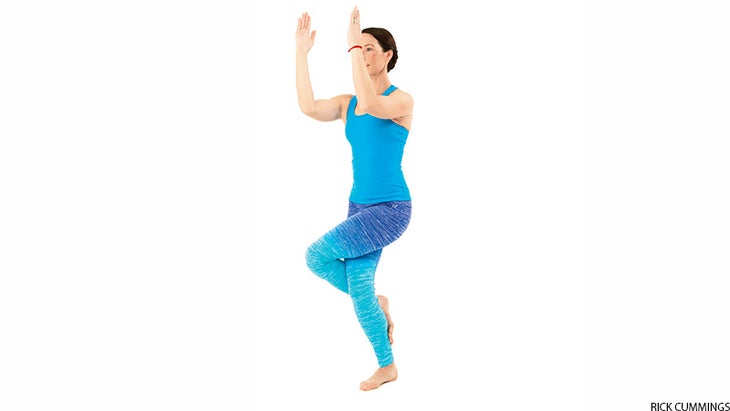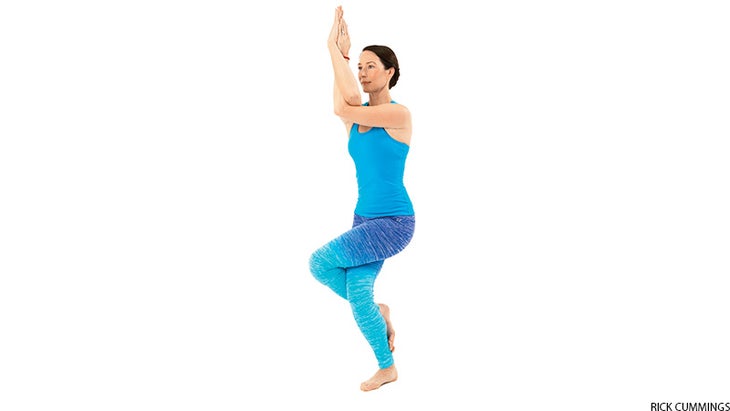Heading out the door? Read this article on the new Outside+ app available now on iOS devices for members! Download the app.
Move step by step into Eagle Pose with strength and balance.
PREVIOUS STEP IN YOGAPEDIA 3 Prep Poses for Eagle
SEE ALL ENTRIES IN YOGAPEDIA
Benefits
Improves balance; strengthens your inner thighs and ankles; stretches your calves and upper back
Step 1

Stand in Tadasana (Mountain Pose), with your hands on your hips. Lift and spread the toes on your right foot while grounding down through its ball and heel; press the toes down to create a solid foundation. Bend your knees and sit your hips back slightly.
See also 8 Steps to Master and Refine Tree Pose
Step 2

Lift your left leg and cross it over your right thigh. Snake the toes of your left foot around the back of your right calf. Alternatively, you can place your toes on the floor or a block beside your standing foot. Take a few breaths here to find your balance. It’s important to recognize that balance is a dynamic, not static, process, meaning you will experience fluctuations throughout the pose. Try not to get discouraged. Direct your drishti, or gaze, to a single point, which will help you to calm and focus your mind.
See also Twist Up To Unwind: Eagle Pose
Step 3

Goalpost your arms by lifting them to shoulder height and flexing your elbows to a 90-degree bend; bring your arms in front of your chest while drawing your shoulder blades away from each other. Put on your imaginary corset to tighten your core. Keep your gaze and breath steady and relaxed.
See also Warrior II Pose
Step 4

Cross your left arm underneath the right, and then wind the right forearm around the left. Bring your palms together, with your fingers pointing up. Keep your torso upright and shoulders in line with your hips. Re-engage your shoulder blades by broadening across your chest.
Garudasana
Garuda = mythic king of the birds · asana = pose
Eagle Pose
See also 5 Yoga Poses We Have to Admit Are Pretty Crazy
Step 5

To deepen the posture, try lifting your arms up toward the sky while maintaining integrity in your shoulders and core. You shouldn’t feel as though your shoulders are crowding your neck or that your low ribs are lifting away from the front of your pelvis. Play with sitting deeper into the squat, being mindful to maintain the tripod effect in the standing foot and a neutral curve in the lumbar spine. Stay for 5 to 10 breaths before returning to Mountain Pose; repeat the posture on the other side.
Stay safe
To avoid injury in Eagle Pose, maintain a keen awareness of the integrity of your core. If at any time you feel as though you cannot engage your core muscles, back off until you can feel the equilibrium between expansion and contraction. Trying to sit too low may cause the top of your pelvis to tip forward and your low back to overarch. You’ll know you’ve gone too far if you feel a compression or pinching in your low back, or if your belly is expanding, breaking out of that imaginary corset. As with all standing poses, your feet are your foundation. If you feel the weight start to deviate too far forward or backward from the tripod sensation, back out until you regain your base stability.
See also Challenge Pose: Flying Pigeon (Eka Pada Galavasana)
About Our Pro

Teacher and model Robyn Capobianco, MA, E-RYT 500,is a corrective-exercise specialist; her classes are a unique blend of self-myofascial release, classical yoga, and corrective exercise interspersed with splashes of science. Capobianco’s work is inspired by her studies with Jill Miller, Sianna Sherman, Richard Freeman, and Douglas Brooks, as well as by her formal education in integrative physiology. She is also a doctoral student in the Neurophysiology of Movement Laboratory at the University of Colorado, Boulder, and is investigating the neuromechanics of stretching and yoga. Learn more at functionalflow.com.